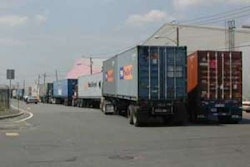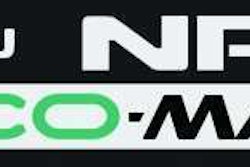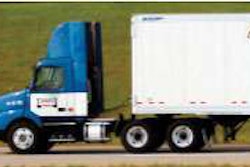EPA revises emissions guidance
Navistar continues legal challenge over SCR
 Final briefs in the litigation over EPA’s SCR guidance are due April 9 to the U.S. Court of Appeals for the District of Columbia, which could decide emissions technology at least in the near term depending on how it rules.
Final briefs in the litigation over EPA’s SCR guidance are due April 9 to the U.S. Court of Appeals for the District of Columbia, which could decide emissions technology at least in the near term depending on how it rules.Under legal pressure from Navistar, the U.S. Environmental Protection Agency revised its 2010 engine emissions guidance regarding the number of miles and hours a vehicle using selective catalytic reduction technology can operate after the diesel exhaust fluid is exhausted. The original guidance issued in February 2009 required engine performance to be degraded after a truck travels 2,000 miles or 40 hours on an empty DEF tank. The revision removes this provision and eliminates specific limits on mileage or time trucks should operate with empty DEF tanks.
Navistar sued EPA over that guidance, saying that the agency could not allow SCR without an opportunity for public comment, such as through a formal rulemaking process. The truck maker, which is not using SCR to comply with 2010 emissions-reduction rules, argued that EPA’s regulation in 2001 stated that SCR would not be feasible.
In October, EPA asked a federal appeals court for a 60-day stay to halt legal proceedings, saying it would be reconsidering the guidance. The court rejected EPA’s request, but the agency reissued the guidance anyway. In a Dec. 30, 2009, letter to engine manufacturers, Karl Simon, director of compliance and innovative strategies at EPA’s Office of Transportation and Air Quality, explained the revision as clarification in a misunderstanding of the intent of the guidance.
“Because some prescriptive language in CISD-09-04 may have led to confusion regarding our intent that the document be used as guidance, rather than setting forth binding requirements, I believe it is appropriate to provide a new document providing revised guidance regarding certification of heavy-duty diesel engines using SCR,” Simon said.
In a supplemental brief filed last month, Navistar said that if the new guidance supercedes the old, “the result is nevertheless the same.” The truck maker contends that the new guidance merely renames the previous “certification requirements” as “possible approaches” and substitutes the words “reasonably short” mileage for the specific mileage during which no NOx control is required. Navistar argues the new guidance remains a legislative rule because it relaxes the 0.2 gram NOx standard and establishes a new SCR-specific emissions standard.
EPA has until March 11 to respond to Navistar’s claims. Final briefs in the case are due April 9. While continuing to pursue its litigation against EPA over the February and December 2009 guidance, Navistar also is suing the agency over its November 2009 approval of scheduled maintenance intervals for SCR technology.
In brief
* ACT Research Co. is forecasting the truck transportation sector will strengthen in the second half of 2010, leading to stronger demand for commercial vehicles late this year and in 2011. The research firm also expects Class 8 vehicle production to rise 18 percent year-over-year in the first half of this year, largely due to stronger orders late in 2009 in advance of the U.S. Environmental Protection Agency’s 2010 emissions mandate and poor production rates last year.
* John Ruan, founder of Des Moines, Iowa-based Ruan Transportation Management Systems, died last month at 96. Ruan, who founded his company in 1932 with one truck, also established a foundation that sponsors the World Food Prize, which recognizes individuals for improving the quality, quantity or availability of food in the world.
* IdleAire has ceased operations. The company had operated 131 locations in 34 states, providing filtered heating and air conditioning, electrical outlets and a range of communications and entertainment options at truckstops.
* A study commissioned by the National Association of Regulatory Utility Commissioners projected that the nation’s reliance on foreign energy would grow by 19 percent over the next 20 years due to restrictive policies on exploration of domestic oil and gas resources.
* U.S. Department of Transportation last month awarded $1.5 billion in grants to 51 road, bridge, rail, port, transit and intermodal projects across the country. The projects – chosen from among 1,400 applications – were selected based on several criteria, including contribution to the nation’s economic competitiveness, improvements to the safety and the condition of the existing transportation system, increased quality of life and reduced greenhouse gas emissions.
* Navistar Financial Corp. obtained $250 million in financing to support its dealer inventory funding.
* American Trucking Associations announced that Rob Abbott has rejoined the association as vice president of safety policy, succeeding Dave Osiecki, who recently was promoted to senior vice president of policy and regulatory affairs.
* FTR Associates released figures indicating intermodal’s share of U.S. long-haul movements of international and domestic containerized freight grew to 13.3 percent in the fourth quarter, up 0.2 percent from the third quarter and slightly above the previous high-water mark achieved in the 2008 fourth quarter.
* A study presented to Port of Tacoma commissioners shows that 90 percent of the heavy-duty trucks serving terminals meet the port’s 2010 clean truck standards, 4 percent more trucks than a year ago. The Washington State port’s Clean Truck Program’s 2010 standards require trucks to have 1994 model year engines or newer.
Carrier news
* Schneider National plans to expand its Regional driving fleet to 2,500 this year and will target experienced drivers looking for the stability of a large carrier combined with weekly time at home or better.
* YRC Worldwide launched the Green Balance Calculator, an optional tool that allows customers to help offset emissions associated with their shipments by way of certified carbon offsets.
* Celadon Trucking Services received a Sustainability Award from the City of Indianapolis for its initiative to improve fuel efficiency, reduce air emissions and educate employees on the importance of improving environmental performance and sustainability.
YRC to sell $70 million in notes
YRC Worldwide Inc. entered into definitive agreements with investors who have agreed to purchase $70 million in new unsecured convertible notes in a private placement. The company says it will use the proceeds from these new notes to satisfy its remaining 2010 note obligations, with any excess proceeds available to be used for general corporate purposes.
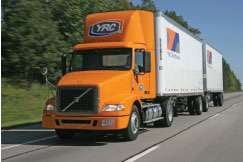 YRC Worldwide Inc. says its recent debt-for-equity exchange has bolstered customer confidence.
YRC Worldwide Inc. says its recent debt-for-equity exchange has bolstered customer confidence.“We are pleased to announce this important step to satisfy our remaining 2010 note obligations,” says Bill Zollars, chairman and chief executive officer of YRC Worldwide. “Upon the closing of this funding, our management team will be able to focus on operational improvements without the financial overhang related to these debt maturities that have concerned our customers in recent months. Both the company and our customers will be able to put this distraction behind us with the completion of this financing.”
In an earlier announcement, YRC Worldwide Inc. said its recent debt-for-equity exchange had bolstered customer confidence. “As more and more customers become aware of our restored financial strength, they are showing their confidence in us with their business,” Zollars says. The company had retained an independent research firm to survey transportation decision makers. Of the more than 5,700 respondents, a majority (62 percent) are optimistic that their business levels will increase in 2010, YRC says. Among regular shippers, 85 percent intend to increase or maintain their business levels with YRC Worldwide companies.
YRC Inc., a subsidiary of YRC Worldwide, recently introduced of a “No-fee, Money-back Standard Service Guarantee.” Shippers now automatically are eligible to receive a 100 percent refund if their shipments fail to deliver on the scheduled day of service.
CCJ a finalist for Neal Award
Commercial Carrier Journal’s coverage of the 2010 engine emissions regulations is in the running for a major business journalism award. The July 2009 cover story “The main event” is a finalist for the American Business Media’s Jesse H. Neal National Business Journalism Award in the category of best technical content. The article, written primarily by Executive Editor Jack Roberts, explores the various issues surrounding the choice of technologies to meet U.S. Environmental Protection Agency emissions requirements. Editorial Director Avery Vise contributed to the article and edited it along with Managing Editor Dean Smallwood. Winners of the Neal Awards will be announced March 11 in New York.
Navistar’s SuperTruck team details efforts
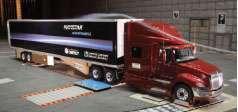 Aerodynamics work at NASA’s Ames Research Center is expected to help achieve a 12 percent gain in fuel economy for the SuperTruck development team headed by Navistar.
Aerodynamics work at NASA’s Ames Research Center is expected to help achieve a 12 percent gain in fuel economy for the SuperTruck development team headed by Navistar.The scope of work by one team involved in the U.S. Department of Energy’s SuperTruck initiative is becoming clearer. Navistar, which is leading one of the three SuperTruck teams, is working with the Lawrence Livermore National Laboratory (LLNL), NASA’s Ames Research Center, the U.S. Air Force and various industry partners. In January, DOE announced more than $115 million in funding for the SuperTruck initiative, which aims to produce truck prototypes that achieve a 50 percent increase in fuel economy within five years. (For more on SuperTruck, see “Quantum Leap,” CCJ February 2010.)
At a news conference last month at NASA’s Ames Research Center at Moffett Field in California, officials with Navistar, LLNL and Ames outlined a portion of the SuperTruck effort that involves reducing the aerodynamic drag of tractor-trailers.
LLNL computer simulations have identified critical drag-producing regions around the trucks, such as the trailer base, the underbody and the gap between tractor and trailer. LLNL scientists estimate that with aerodynamic devices placed in these regions, the trucking industry could see as much as a 20 percent increase in mileage fuel efficiency rate.
“This is a technology that could easily be installed on the tractor-trailer trucks that are out on the highway today,” says Kambiz Salari, LLNL’s lead scientist on the project. “In just three years, we could see these devices on the road and realize the real fuel savings.”
The lab is conducting a full-scale test in the world’s largest wind tunnel, the National Full-Scale Aerodynamics Complex (NFAC), which operates under the direction of the Arnold Engineering Development Center at Ames. The goal is to identify drag-reduction devices, both commercially available and under development, that show the potential for improving fuel efficiency. The wind tunnel test section is 80-by-120 feet, allowing testing with a full-scale tractor and 53-foot trailer.
The commercially available devices to be tested are manufactured by Aerofficient, Aeroindustries, ATDynamics, Freightwing, Ladyon and Windyne. Prototype devices currently under development will be provided by LLNL and Navistar, which are collaborating to get proven drag-reduction devices on the road. Performance will be evaluated under different tractor-trailer combinations.
The aerodynamics work being done with LLNL at Ames will achieve about a 12 percent improvement in fuel efficiency, so there is much more work to be done to achieve the 50 percent improvement target.
“We’re throwing the kitchen sink at it, from the engine, to the tractor, to the trailer – anything that can affect fuel economy,” says Steve Bruford, vice president of vehicle product development at Navistar Truck Group. Navistar expects about 20 percent of the total improvement in fuel economy to come from efficiencies under the hood. The rest will result from changes in aerodynamics and tires and from lighter materials.
Navistar is lining up partners such as aerodynamic device maker ATDynamics, trailer manufacturer Wabash National, fleet operators Swift Transportation and Safeway and a tire maker to work on the project and help defray Navistar’s financial share. Initial testing will begin later in the year under the five-year program.
This month, Navistar will display a prototype of a system that automatically will move the fifth wheel to adjust the gap between the back of the truck cab and the trailer to optimize aerodynamics. The system, which would slide the trailer back and forth to maximize aerodynamic efficiency at highway speeds, would operate independent of the driver but react almost instantly in an emergency. “The key is safety,” says Ron Schoon, Navistar chief engineer of aerodynamics. “We’re testing exactly how far the device can move before its locking feature engages. Depending on your configuration and how your trailer is loaded, it will always run as close to the (truck) as possible.”
Schoon says Navistar is talking with fifth-wheel manufacturers about the system and perhaps partnering with a company to accelerate the product’s development. Separately, fifth-wheel supplier Jost International last month announced it is developing such a solution and displayed a working prototype at the Technology & Maintenance Council annual meeting in Tampa, Fla.
Navistar intends to leverage the DOE projects and other company research to develop a new fuel-efficient truck model in five to seven years, Bruford predicts. The company wants to take the aerodynamic ProStar “to the next level.”
– Max Kvidera and Avery Vise
Trucking employment rises in January
The trucking industry added 2,500 jobs in January, but the job loss in December turned out to be far more severe than preliminary estimates. Revised figures released in February by the U.S. Department of Labor’s Bureau of Labor Statistics show that trucking lost nearly 13,000 jobs on a seasonally adjusted basis in December. The preliminary data release a month ago estimated that the for-hire trucking industry had lost 3,300 jobs in December.
Other BLS revisions to its historical data change the recent picture slightly. For example, the prior figures showed a 500-job increase for for-hire trucking in September; instead, new figures show a loss of 1,400 jobs that month. On the other hand, the revised figures show a gain of 2,500 jobs in November, while the old numbers indicated a loss of 3,600 jobs.
Trucking employment in January was down more than 84,000, or 6.4 percent, from January 2009. BLS preliminary numbers show total payroll employment in trucking of more than 1.23 million in January. According to the latest BLS numbers, the trucking industry has lost more than 220,000 jobs – or 15.2 percent – since seasonally adjusted trucking employment peaked in January 2007 at more than 1.45 million.
The BLS numbers reflect all payroll employment in for-hire trucking, but they don’t include trucking-related jobs in other industries, such as a truck driver for a private fleet.
CCJ selects O&S Trucking as Innovator of the Year
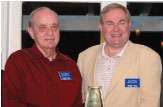 Rick Johnson, COO of O&S Trucking, left, and Jim O’Neal, president, accept Commercial Carrier Journal’s Innovator of the Year award at the annual CCJ Innovators Summit.
Rick Johnson, COO of O&S Trucking, left, and Jim O’Neal, president, accept Commercial Carrier Journal’s Innovator of the Year award at the annual CCJ Innovators Summit.Springfield, Mo.-based O&S Trucking’s efforts to carry the same amount of freight in nine loads that used to take 10 and to brand that offering to gain a competitive edge earned the trucking company the distinction as Commercial Carrier Journal’s 2010 Innovator of the Year. O&S Trucking executives received the award at the annual CCJ Innovators Summit, which was held Feb. 3-5 in Duck Key, Fla. CCJ will cover O&S Trucking’s accomplishments in detail in the April issue.
Other finalists for Innovator of the Year – all recognized in 2009 – were Bay & Bay Transportation, Averitt Express, Con-way Freight, The Evans Network, U.S. Foodservice, Bison Transport, Ruan Transportation, Transport America, USA Truck and Carlile Transportation Systems. The CCJ Innovators program is sponsored by Castrol, J.J. Keller and PeopleNet.
To learn more about the CCJ Innovators program, visit www.ccjinnovators.com.
Monthly freight index unchanged
The Freight Transportation Services Index was unchanged in December from its November level after one monthly increase, the U.S. Department of Transportation’s Bureau of Transportation Statistics reported. Though the Freight TSI declined 4.1 percent during 2009, the index increased 2.9 percent over the last seven months of the year, beginning in June.
The December Freight TSI of 96.2 is a 2.9 percent increase from the recent low of 93.5 reached in May, when the index was at its lowest level since June 1997.
The 4.1 percent decline in the Freight TSI from December 2008 to December 2009 was the fourth-largest annual decline in the 20 years for which the TSI is calculated. It was the third-largest decline in the past decade, exceeded by declines in 2000 and 2008.
ATA calls for oil speculation controls
The American Trucking Associations last month called for transparency in the over-the-counter petroleum markets. Speaking at a news conference on behalf of ATA, Con-way Inc. Vice President Randy Mullett told a subcommittee that Congress should establish aggregate position limits across all trading platforms.
“While we cannot quantify the extent to which excessive speculation is responsible for the recent dramatic increases in the price of crude oil, we believe that it is a significant part of the problem,” Mullett says.
In addition to Mullett, speakers at the press conference included U.S. Sen. Maria Cantwell (D-Wash.) and other representatives of the Derivatives Reform Alliance (DRA). The DRA is composed of members of the Commodity Markets Oversight Coalition and Americans for Financial Reform.
The Commodity Futures Trading Commission has taken an initial step in proposing position limits for energy trades on certain commodities exchanges, Mullett says. “However, this step by itself is insufficient to curb the problem of excessive speculation. Congress must act to broaden the CFTC’s authority and eliminate trading loopholes. The failure to apply position limits across all trading platforms creates a loophole that permits excessive speculation beyond the control of government regulators.” n



